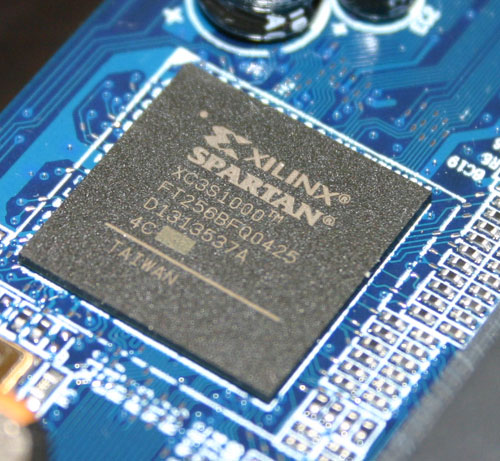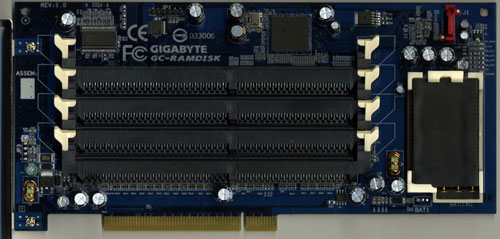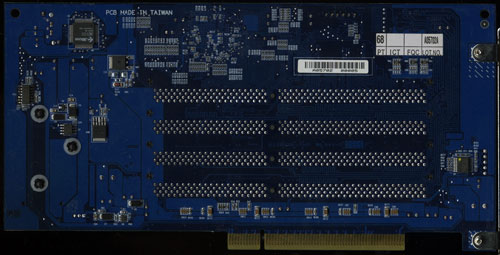Gigabyte's i-RAM: Affordable Solid State Storage
by Anand Lal Shimpi on July 25, 2005 3:50 PM EST- Posted in
- Storage
We All Scream for i-RAM
Gigabyte sent us the first production version of their i-RAM card, marked as revision 1.0 on the PCB.There were some obvious changes between the i-RAM that we received and what we saw at Computex.
First, the battery pack is now mounted in a rigid holder on the PCB. The contacts are on the battery itself, so there's no external wire to deliver power to the card.


The Xilinx FPGA has three primary functions: it acts as a 64-bit DDR memory controller, a SATA controller and a bridge chip between the memory and SATA controllers. The chip takes requests over the SATA bus, translates them and then sends them off to its DDR controller to write/read the data to/from memory.
Gigabyte has told us that the initial production run of the i-RAM will only be a quantity of 1000 cards, available in the month of August, at a street price of around $150. We would expect that price to drop over time, and it's definitely a lot higher than what we were told at Computex ($50).
The i-RAM is outfitted with 4 184-pin DIMM slots that will accept any DDR DIMM. The memory controller in the Xilinx FPGA operates at 100MHz (DDR200) and can actually support up to 8GB of memory. However, Gigabyte says that the i-RAM card itself only supports 4GB of DDR SDRAM. We didn't have any 2GB unbuffered DIMMs to try in the card to test its true limit, but Gigabyte tells us that it is 4GB.
The Xilinx FPGA also won't support ECC memory, although we have mentioned to Gigabyte that a number of users have expressed interest in having ECC support in order to ensure greater data reliability.
Although the i-RAM plugs into a conventional 3.3V 32-bit PCI slot, it doesn't use the PCI connector for anything other than power. All data is transfered via the Xilinx chip and over the SATA connector directly to your motherboard's SATA controller, just like any regular SATA hard drive.

With SATA as the only data interface, Gigabyte made the i-RAM infinitely more useful than software based RAM drives because to the OS and the rest of your system, the i-RAM appears to be no different than a regular hard drive. You can install an OS, applications or games on it, you can boot from it and you can interact with it just like you would any other hard drive. The difference is that it is going to be a lot faster and also a lot smaller than a conventional hard drive.
The size limitations are pretty obvious, but the performance benefits really come from the nature of DRAM as a storage medium vs. magnetic hard disks. We have long known that modern day hard disks can attain fairly high sequential transfer rates of upwards of 60MB/s. However, as soon as the data stops being sequential and is more random in nature, performance can drop to as little as 1MB/s. The reason for the significant drop in performance is the simple fact that repositioning the read/write heads on a hard disk takes time as does searching for the correct location on a platter to position them. The mechanical elements of hard disks are what make them slow, and it is exactly those limitations that are removed with the i-RAM. Access time goes from milliseconds (1 x 10-3) down to nanoseconds (1 x 10-9), and transfer rate doesn't vary, so it should be more consistent.
Since it acts as a regular hard drive, theoretically, you can also arrange a couple of the i-RAM cards together in RAID if you have a SATA RAID controller. The biggest benefit to a pair of i-RAM cards in RAID 0 isn't necessarily performance, but now you can get 2x the capacity of a single card. We are working on getting another i-RAM card in house to perform some RAID 0 tests. However, Gigabyte has informed us that presently, there are stability issues with running two i-RAM cards in RAID 0, so we wouldn't recommend pursuing that avenue until we know for sure that all bugs are worked out.












133 Comments
View All Comments
Icehawk - Monday, July 25, 2005 - link
Huh, if this was at the $50 price point it would be a bit more interesting.I didn't like the pagefile test - it made no sense at all. Of course going from say 4b RAM to 2gb + 2gb iRam isn't going to improve the system... You needed to test what JUST changing the pagefile from HD to iRAM does.What about a typical 1gb RAM setup that most of us use? I still hit the pagefile on occasion and I do have ~1gb of old DDR I could use. Load times? No, I'd like to know if it smooths out gameplay. I know Doom 3 hiccups on my machine due to disk accesses.
Otherwise this doesn't look like it makes a lot of sense in its current incarnation.
lewis71980 - Monday, July 25, 2005 - link
No mention of using JBOD instead of Raid 0.That way with 4 pci slots used up you could get 16gb.
Maybe that would be enough space to do some proper server / databases.
Use a pair of normal 80 IDE HDD for os boot in raid 1 with file backup, from the i Ram card.
Braxus - Monday, July 25, 2005 - link
Know the article says it doesn't support ECC memory but will it still take it and run in in non-ECC mode? Most mobos I believe can at least do this. What about registered memory? Got a couple sticks of 1GB DDR266 RECC memory I'd like to use!RMSistight - Monday, July 25, 2005 - link
I definitely won't purchase this product until they implement SATA-II at 300Gb/s. Why should I shell out $150 for SATA150 when my DFI LanParty Ultra-D can do 300.I even asked one of the product managers at the AMD tech tour. I don't see why they wouldn't do it since SATA-II is backwards compatible to SATA-I.
Hacp - Monday, July 25, 2005 - link
BTW I hate this new layout. i have to click it to read the next comment. Is there anyway to fix this? also the forums didn't get a makeover visual wise.LeftSide - Monday, July 25, 2005 - link
I wonder If the athlon x2 would have shown a diffrence in the multitaking tests, Instead of useing a fx57?Nanobaud - Monday, July 25, 2005 - link
If more benches are to be done, I would put in a suggestion to test some compile times. Then I guess you should compare it to boosting youe system memory and installing a RAM drive, but this could be more convenient if you have those old 256 / 512 MB memory sticks lying around.nBd
Sunbird - Monday, July 25, 2005 - link
I want to know how long it will take the I-RAM to drain a standard UPS if the PC is off but connected to said UPS?jkostans - Tuesday, July 26, 2005 - link
A while. You would have to find how much power is dissipated by the i-ram, then use the capacity of your UPS to get an exact number. I would go as far as to say maybe up to a month if you have a good ups.Zebo - Monday, July 25, 2005 - link
$600 for 4GB (read useless) drive that maybe is not much faster than two 73GB drives in RAID 0 for half price? Uh Huh. If they sell 3000 I'll be shocked.